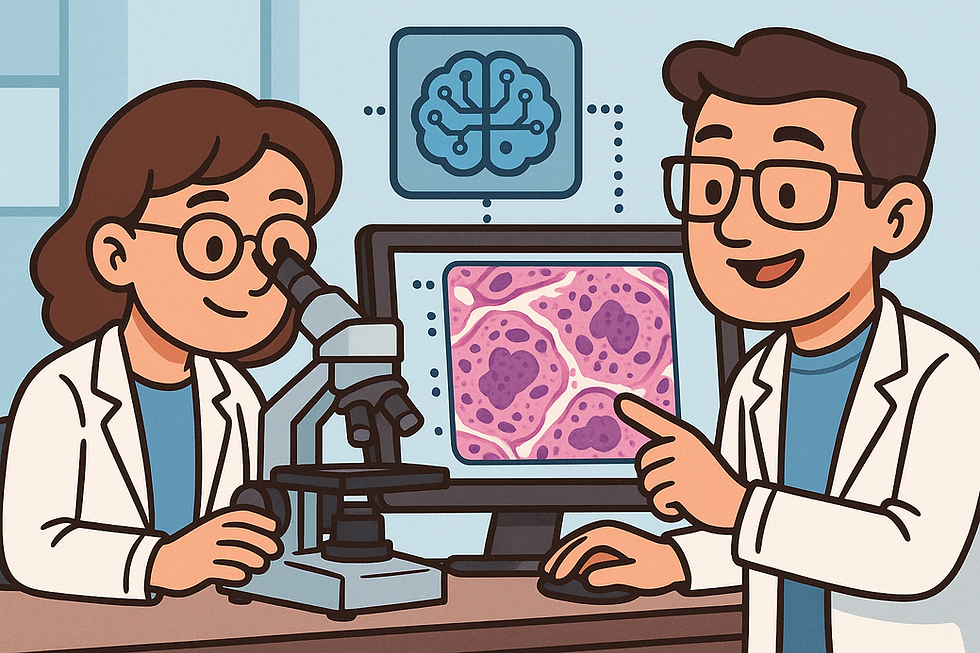How Paradromics's Brain Implant Is Giving Voice Back to Those Who Can't Speak
- Zofia Krajewska
- Jul 19
- 3 min read
Updated: Aug 21
In a dimly lit lab in Austin, a tiny coin-sized device lies among a pile of microelectrodes: an unassuming piece of hardware that may one day shout the unspoken thoughts of someone trapped in silence. That’s Connexus, the brain-computer interface at the heart of Paradromics’ mission, and it’s set to change everything for people locked behind paralysis. Paradromics was founded in 2015 by Matt Angle, a neuroscientist driven by a vision: to crack open the brain’s bandwidth by tapping directly into individual neurons.
Today, Paradromics' clinical precision outpaces Neurolink, and delivers what few others can: a fully implantable, wireless neural interface capable of recording from up to 1,684 electrodes across multiple cortical modules. Each module, just 1.5 mm deep, sniffs signals from individual neurons. A tiny internal transceiver sends data through the skin via secure infrared at up to 100 Mbit/s and draws power inductively. That data is then decoded by machine learning and advanced language models to restore speech, control cursors, or guide assistive devices, all in real time.
The problem is simple yet profound: people with ALS, spinal cord injury, or stroke often have intact minds trapped in bodies that no longer obey. Existing systems, like eye-trackers or low-bandwidth BCIs, are slow, frustrating, and limited. Paradromics solves it by increasing neural bandwidth and precision, enabling fluid, near-natural communication.
What sets Connexus apart?
What sets Connexus apart is that while maintaining high resolution, it is minimally invasive -- with microelectrodes thinner than a strand of hair, the implant minimizes cortical damage and scarring while maximizing signal fidelity. Competing systems, like Synchron and Precision Neuroscience, opt for surface or vascular access at lower resolution, while Neuralink goes deep but trades off electrode density and wireless maturity.

In June 2025, during an epilepsy procedure at the University of Michigan, surgeons implanted Connexus temporarily, recorded neural signals, and removed the device, cleanly and in under 20 minutes, demonstrating safety, precision, and surgical feasibility. Matt Angle called it “a key inflection point… now a clinical-stage company,” adding that it proved Connexus could “be safely implanted, record electrical brain signals, and be removed intact”.
After raising $20 million in seed funding in mid‑2021, supported heavily by Prime Movers Lab, NIH and DARPA, the team secured $33 million in Series A in May 2023. It also secured an FDA Breakthrough Device designation for its first human-use interface. Cumulatively, the company has pulled in over $105 million from venture rounds plus $18 million from public grants.
Commercially, Paradromics is staging a thoughtful go-to-market (GTM) approach. They’re focusing first on high-needs, high-reward use cases, namely, assistive communication for locked‑in patients. This initial clinical segment acts as both moral imperative and strategic proof point. Data from these trials will also pave the way to broader applications: motor control, sensory restoration, chronic pain management, and even psychiatric disorders. Early wins here will justify premium reimbursement and build compelling validation for later entrants.
What lies ahead?
Within the year, Paradromics aims to launch long‑term implant trials in people with severe speech and motor impairments. Meanwhile, they’re advancing multi-module implants, scaling AI decoding stacks, and integrating new electrode materials for longevity, pushing past the 100-bit‑per‑second plateau toward conversational bandwidth.
Paradromics’ story isn’t just about chips and code; it’s about restoring voice and agency to lives sidelined by neurological injury. Their finely calibrated tech, deep funding runway, clinical-forward GTM strategy, and early regulatory wins create a compelling investment case. The proof now lies in the upcoming trials. But if the Connexus device continues its trajectory, investors and patients alike may one day call it a transformative neurotechnology.




Comments